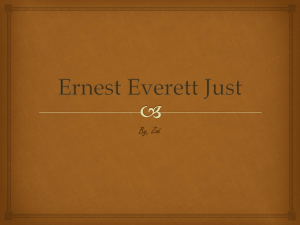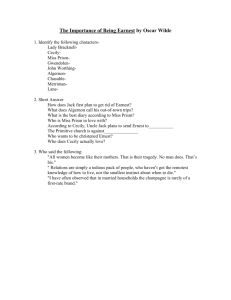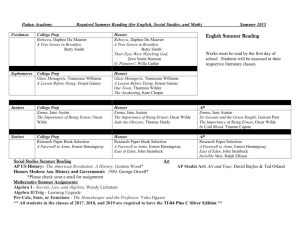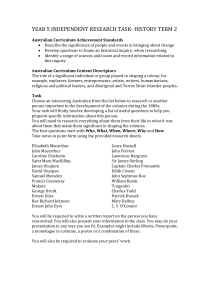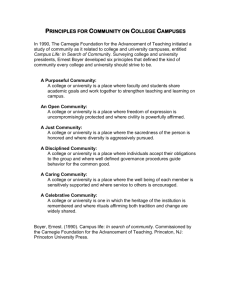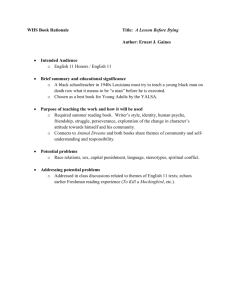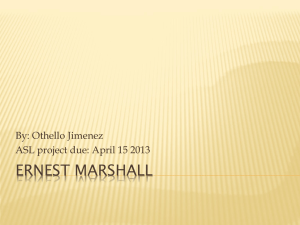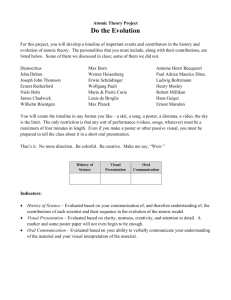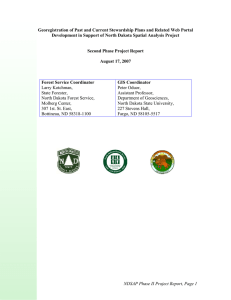csa2070_Formal_slides
advertisement
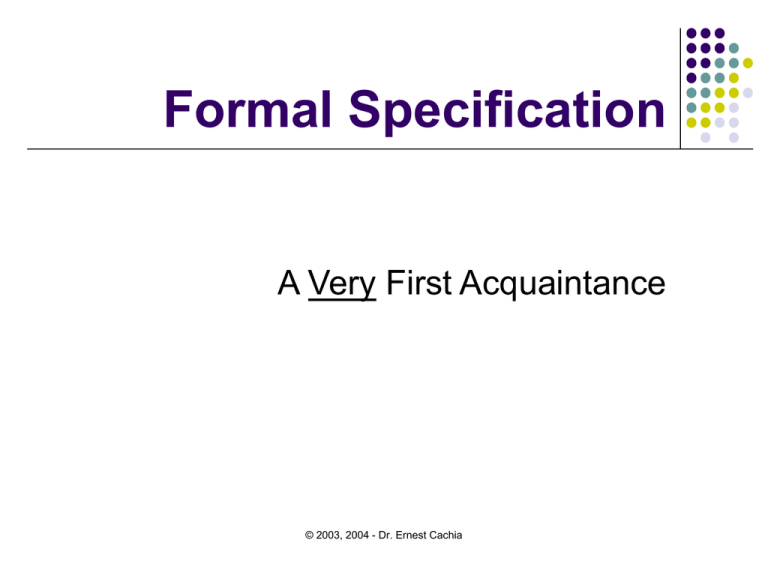
Formal Specification
A Very First Acquaintance
© 2003, 2004 - Dr. Ernest Cachia
What is Formal Specification
The application of set theory, propositional
and predicate calculi to the specification of
systems.
© 2003, 2004 - Dr. Ernest Cachia
Slide: 2
Sets
Are collections of elements
Are represented by standard notation
Are manipulated by standard elementary
operations
Are entities which can interact with each
other
© 2003, 2004 - Dr. Ernest Cachia
Slide: 3
Examples of Sets
Notation: { }
Set of colours:
Set of sports:
Set of
BCIS SEM tutors:
Empty set:
{green,blue,yellow}
{tennis,football, equestrian}
{ernest}
{ } or
© 2003, 2004 - Dr. Ernest Cachia
Slide: 4
Set Construction
Direct (as in previous slide)
Operations on other sets according to the form:
The resulting set whose elements are formed by the
operation on elements selected by the condition from
the original set with elements from range.
Translates to…
{set : range | condition operation}
In notational form (aka comprehensive specification):
{Signature | Predicate • Term}
{x : X | P( x) E ( x)}
© 2003, 2004 - Dr. Ernest Cachia
Slide: 5
Set Construction Examples
Alternate even numbers:
{ x : N | x mod 2 = 0 ∙ 2 * x } = {0,4,8,12,16,20,…}
Tens:
{ x : N | x ∙ 10 * x } = {0,10,20,30,40,…}
Squares of multiples of 4 (excluding zero):
{ x : Z | (x mod 4 = 0) (x > 0) ∙ x * x }
= {16,64,144,256,…}
© 2003, 2004 - Dr. Ernest Cachia
Slide: 6
Some Set-Based Specification
Exercises
Write 3 elements from the sets specified by the
following comprehensive specifications:
{n : N | n < 20 n > 10 • n}
{n : N | n3 > 10 • n}
{x,y : N | x + y = 100 • (x,y)}
{x,y : N | x + y = 5 • x2 + y2}
Interpret the following:
{m : monitors | MonitorState(m, on) • m}
{f : SysFiles | f DelFiles f ArcFiles • f}
Write the comprehensive specification of:
{(10,100),(11,121),(12,144),(13,169),(14,196)}
© 2003, 2004 - Dr. Ernest Cachia
Slide: 7
Set Operators
Operator list in NCC slide and handout (notes).
Examples:
Mosta {Maltese towns}
London {Maltese towns}
#{joe,veronica,mark} = 3
{paul,richard,claire,george} {Group B}
IP{milan,juve} = { { },{milan},{juve},{milan,juve} }
{dobie,collie,poodle} {poodle,labrador} =
{dobie,collie,poodle,labrador}
{dobie,collie,poodle} {poodle,labrador} = {poodle}
{dobie,collie,poodle} \ {poodle,labrador} = {dobie,collie}
© 2003, 2004 - Dr. Ernest Cachia
Slide: 8
Propositional Calculus
Deals with logic
Basically consists of statements which can be
true or false (Excluded Middle Law)
Are mutually exclusive - never true or false at
the same time (Contradiction Law)
Is fundamental
Is axiomatic
In theory, can be used to describe anything
© 2003, 2004 - Dr. Ernest Cachia
Slide: 9
Proposition (and not)
Examples
Some birds can fly
The nation Malta is in Asia
Dogs are mammals
All fish live in water
All fish live in sea water
Monique is the only lady in our group
Cikku qatt ma jgorr
Sit down.
How are you today?
Get my tea, please.
What is the weather like?
© 2003, 2004 - Dr. Ernest Cachia
ARE
ARE NOT
Slide: 10
Representing Propositions
Consider the following…
10 is greater than 8
8 is less than 10
8 < 10
10 > 8
There is a positive number such that if we
add it to eight the result would be ten.
All the above are one and the same proposition
© 2003, 2004 - Dr. Ernest Cachia
Slide: 11
Propositional Calculus
Notation
Please refer to the R. Pressman textbook, or
any other Software Engineering textbook
containing basic formal specification, for a
listing of basic propositional operators.
© 2003, 2004 - Dr. Ernest Cachia
Slide: 12
Examples to Discuss
Taking:
P as true
Q as false
R as false
S as true
(( P Q) Q)
(( P Q) R) P
P ( P (Q P ))
(( P Q) ( R S ) ( P R)) (Q S )
Click again for answers… Answers:
1. TRUE
2. FALSE
3. FALSE
4. FALSE
© 2003, 2004 - Dr. Ernest Cachia
Slide: 13
Contradictions and
Tautologies
A contradiction is a proposition that is always
false for all possible values and variables
making it up
A tautology is a proposition that is always true
for all possible values and variables making it up
Examples:
a a
a a
( a b c ) (c a )
© 2003, 2004 - Dr. Ernest Cachia
contradiction
tautology
tautology
Slide: 14
De Morgan’s Laws
( P Q) P Q
( P Q) P Q
The above can be summarised (in Maltese) as follows:
Jekk mhux abjad u iswed (it-tnejn me]udin f’daqqa) ifisser li mhux
abjad jew mhux iswed. Mentri, jekk mhux abjad jew iswed (l-ebda
wa]da minnhom) ifisser li mhux abjad u mhux iswed.
…g]a[nuha ftit f’mo]]kom!
© 2003, 2004 - Dr. Ernest Cachia
Slide: 15
Specifying with Propositions
Consider the following text:
The system is in alert state only when it is
waiting for an intruder and is on practice
alert.
alert waiting practice
If the system is in teaching mode and is on
practice alert, then it is in alert state.
teaching practice alert
The system will be in teaching mode and on
practice alert and not waiting for an
intruder.
teaching practice ¬ alert
Therefore…
© 2003, 2004 - Dr. Ernest Cachia
Slide: 16
Detecting Contradictions
From the previous system:
alert waiting practice
teaching practice alert
teaching practice ¬alert
The second and third propositions yield a contradiction:
teaching practice alert
teaching practice ¬alert
alert ¬alert …contradiction!
The first proposition yields another contradiction:
teaching practice ¬(waiting practice) eventually simplifies
to…
alert ¬waiting …contradiction because alert requires waiting!
© 2003, 2004 - Dr. Ernest Cachia
Slide: 17
Predicate Calculus
1.
2.
Can be viewed as conditional statements
obeying propositional behaviour with
specific values.
b
a
Consider a triangle…
c
We can say the following…
Any side will be greater than zero length;
The sum of the length of any two sides will
be greater than the length of the remaining
side. Therefore…
© 2003, 2004 - Dr. Ernest Cachia
Slide: 18
Predicate Calculus Example
(clarified from NCC material)
In predicate calculus form the basic properties of a triangle
could be written as follows:
a 0b 0c 0 a b c b c a a c b
Property 1
Property 2
© 2003, 2004 - Dr. Ernest Cachia
Slide: 19
Consider This Statement
Fido is a dog, dogs like bones so Fido
likes bones.
Propositional analysis of this sentence yields:
Fido is a dog
(propos. 1) P
Dogs like bones (propos. 2) Q
Fido likes bones (propos. 3) R
Can we derive R from P and Q using only propositional
calculus? – No!
Therefore…
© 2003, 2004 - Dr. Ernest Cachia
Slide: 20
We Introduce “A Predicate”
Formally a predicate can be seen as direct
indicators of object properties.
Examples of unary predicates:
dog(fido)
=true;
dog(lecturer)
=false
Examples of n-ary predicates:
father(john,mary)
team(pawlu,bertu,`ensu)
© 2003, 2004 - Dr. Ernest Cachia
Slide: 21
A More Familiar Predicate
Form
Consider the predicates:
numerically_bigger_than(x,y)
are_equal(a,b)
Can be written as…
x>y
a=b
© 2003, 2004 - Dr. Ernest Cachia
Slide: 22
Quantification
Places bounds on free variables (i.e. names
of objects)
P( x) Is a unary predicate
x P ( x)
x P ( x)
Are propositions
1. There exists an object ‘x’ to which the predicate ‘P(x)’ applies.
2. For all objects ‘x’, the predicate ‘P(x)’ applies.
© 2003, 2004 - Dr. Ernest Cachia
Slide: 23
Quantification Examples
i :1..10 i 64
2
proc : processors ProcessorState( proc, active)
i : i 10 MonitorTemp i
m : AllocatedMonitors MonState(m, ready )
i :1..100; m : AllocatedMonitors
activity (m, functioning ) AmbientTemp i
r : CurrentReactors; m : AllocatedMonitors
MonState(m, functioning ) connected (r , m)
© 2003, 2004 - Dr. Ernest Cachia
Slide: 24
Say the Following in Natural
Language (loosely adopted from Behforooz, A.)
x, y, z x y y z x z
There
exist
x and y from
the
set
There
exists
a numeric
value
x,
All
numeric
values
x,
y,
and
z
for
x x 10 x y 100
{1,2,3,4}
such
that
the sum
of x
such
that
either
x is
greater
than
which
x
is
greater
than
y
and
y
is
If x and y is
arealso
natural
numbers,
a
member
of
the
set
10
or forthan
some
value
y the sum
of
greater
z,
x
is
greater
than
z
then{1,2,3,4}
x+y is also a natural number
x, y N x y N
x and y is less than 100
x, y {1, 2,3, 4} x y {1, 2,3, 4}
x, y {1, 2,3, 4} x y x y {1, 2,3, 4}
For all values x and y from the set
~ ( p q) ~ p ~ q
The
complement
(negation
of) two
{1,2,3,4}
for which
x is greater
The
numeric
value
x is isgreater
logical
AND-ed
values
the same
than
y,
the
difference
between
x
x y x y 0
than
y
if
and
only
if
the
difference
If
of x and
yofiseach
positive,
asthe
thesum
OR-ed
and
ycomplement
is also
an element
of
theit set
between
and y is positive
cannot
bex concluded
that both x
value
{1,2,3,4}
x y 0 x 0 y 0
and y are positive
© 2003, 2004 - Dr. Ernest Cachia
Slide: 25
Algebraic Specifications
A specification technique mainly used for
abstract data types
Based on a strong mathematical foundation –
namely algebra
Have been in use for relatively long periods
of time
Are universal in their application
Employ fundamental principles
© 2003, 2004 - Dr. Ernest Cachia
Slide: 26
Building Algebraic
Specifications
Clearly comprehend the system to model
Determine the operations necessary for the
system you have in mind
Specify the relationship between the system’s
operations
Write the specification down according to
adopted standard (a popular standard is the
Common Algebraic Specification Language –
CASL)
© 2003, 2004 - Dr. Ernest Cachia
Slide: 27
Algebraic Specification Queue
Example (1/2) (loosely adopted from Pressman, R. S.)
A message queue:
Operations:
add an item [AddItem]
remove an item [RemItem]
check if empty [IsEmpty]
get first queue item [GetFirst]
get last item [GetLast]
create a new queue [Create]
© 2003, 2004 - Dr. Ernest Cachia
Slide: 28
Algebraic Specification
Example (2/2) (loosely adopted from Pressman, R. S.)
Type: queue(Z)
Imports: Boolean
Axioms:
IsEmpty(Create)=true
IsEmpty(AddItem(z,q))=false
RemItem(AddItem(z,q),q)=q
GetLast(AddItem(z,q))=z
GetFirst(AddItem(z,Create)=z
Signatures:
Create queue(Z)
AddItem(Z,queue(Z)) queue(Z)
RemItem(Z,queue(Z)) queue(Z)
GetFirst(queue(Z)) Z
GetLast(queue(Z)) Z
IsEmpty(queue(Z)) Boolean
© 2003, 2004 - Dr. Ernest Cachia
Slide: 29
Algebraic Specification Table
Example (1/4) (loosely adopted from Pressman, R. S.)
A symbol table:
Operations: create a new empty table [Create]
add an item [AddItem]
remove an item [RemItem]
check if a symbol is in a table [InTab]
join two tables [Join]
get common symbols [Common]
check if two tables are identical [IsEqual]
check if a table is part of another [IsPartof]
check is a table is empty [IsEmpty]
© 2003, 2004 - Dr. Ernest Cachia
Slide: 30
Algebraic Specification Table
Example (2/4) (loosely adopted from Pressman, R. S.)
Signatures:
Create table(Z)
AddItem(Z,table(Z)) table(Z)
RemItem(Z,table(Z)) table(Z)
InTab(Z,table(Z)) Boolean
IsPartOf(table(Z),table(Z)) Boolean
IsEqual(table(Z),table(Z)) Boolean
IsEmpty(table(Z)) Boolean
Join(table(Z),table(Z)) table(Z)
Common(table(Z),table(Z)) table(Z)
© 2003, 2004 - Dr. Ernest Cachia
Slide: 31
Algebraic Specification Table
Example (3/4) (loosely adopted from Pressman, R. S.)
Some applicable axioms (1):
AddItem(s2,AddItem(s1,s))=if s1=s2 then AddItem(s1,s)
else AddItem(s1,AddItem(s2,s))
RemItem(s1,Create)=Create
RemItem(s1,AddItem(s2,s))=if s1=s2 then
RemItem(s1,s) else AddItem(s2,RemItem(s1,s))
InTab(s1,Create)=false
InTab(s1,AddItem(s2,s))=if s1=s2 then true else
InTab(s1,s)
Join(s,Create)=s
Join(s, AddItem(s1,t))=AddItem(s1,Join(s,t))
© 2003, 2004 - Dr. Ernest Cachia
Slide: 32
Algebraic Specification Table
Example (4/4) (loosely adopted from Pressman, R. S.)
Some applicable axioms (2):
Common(s,Create)=Create
Common(s,AddItem(s1,t))=if InTab(s1,s) then
AddItem(s1,common(s,t)) else common(s,t)
IsPartOf(Create,s)=true
IsPartOf(AddItems(s1,s),t)=if InTab(s1,t) then
IsPartOf(s,t) else false
IsEqual(s,t)=IsPartOf(s,t)IsPartOf(t,s)
IsEmpty(Create)=true
IsEmpty(AddItem(s1,t))=false
© 2003, 2004 - Dr. Ernest Cachia
Slide: 33
“Club” Example
“Club” example will be discussed during
lectures.
© 2003, 2004 - Dr. Ernest Cachia
Slide: 34
The Z-Specification Language
Attempts to place a notational framework on
formal system specification
Based on set theory
Is model-based (relies on well understood
mathematical entities and their relationship)
Equally used to model (specify) state as well
as operations on states
© 2003, 2004 - Dr. Ernest Cachia
Slide: 35
Some Basic Z-Schema
Examples (1/2)
a:
b :{7,1,3, 24}
a b
a is a natural number and b is a set formed of natural
numbers as shown. a is contained in b.
Note: Generically, to indicate “a set of”, the notation “P (with a hollow stem)”.
E.g. b: P N
Linear equivalent would be: [a:N; b:{7,1,3,24} | ab]
© 2003, 2004 - Dr. Ernest Cachia
Slide: 36
Some Basic Z-Schema
Examples (2/2)
a, b :
c:P
ac
bc
Is equivalent to…
a, b :
c:P
a c b c
Or linearly… a, b :
;c : P
|a c bc
© 2003, 2004 - Dr. Ernest Cachia
Slide: 37
Naming Schemas
MonCondition
MonNo :
AvailableMonitors : P
MonNo AvailableMonitors
Or…
MonCondition
[ MonNo : ; AvailableMonitors : P
| MonNo AvailableMonitors]
© 2003, 2004 - Dr. Ernest Cachia
Slide: 38
Z-Schema Decorations
Please refer to R. Pressman or other mainstream Software Engineering textbook.
© 2003, 2004 - Dr. Ernest Cachia
Slide: 39
Z-Schema Conventions
Delta
Denoted by the Greek literal ()
Used to extend the schema components to
indicate update operations, i.e. changes in state
variables (updating operations).
“Xi”
Denoted by the Greek literal ()
Used to indicate that stored data is not affected,
i.e. enquiry operations.
© 2003, 2004 - Dr. Ernest Cachia
Slide: 40
Delta Convention Examples
(taken from Ince)
Specify a system which will keep track of students who have handed in
Assignments. There are clearly three sets involved…
Class
(all the students in the class)
HandedIn
(all the students in the class who have handed in their
assignment)
NotHandedIn (all the students in the class who have not handed in their
assignment)
Assignment
Class, HandedIn, NotHandedIn : P STUDENTS
Class ', HandedIn ', NotHandedIn ' : P STUDENTS
HandedIn NotHandedIn Class
HandedIn NotHandedIn
HandedIn ' NotHandedIn ' Class '
HandedIn ' NotHandedIn '
© 2003, 2004 - Dr. Ernest Cachia
Slide: 41
Use of a Delta Schema (based on
previous example)
Model the handing in of a student assignment:
HandIn
stud ? : STUDENTS
Assignment
Stud ? NotHandedIn
NotHandedIn ' NotHandedIn \{Stud ?}
HandedIn ' HandedIn {Stud ?}
Class ' Class
© 2003, 2004 - Dr. Ernest Cachia
Slide: 42
Use of a “Xi” Schema (based on
previous example)
Model a query for the number of students who have handed in:
Assignment
Class, HandedIn, NotHandedIn : P STUDENTS
Class ', HandedIn ', NotHandedIn ' : P STUDENTS
NotHandedIn ' NotHandedIn
HandedIn ' HandedIn
Class ' Class
Therefore:
AssignQuery
[ HandedIn !: ; Assignment | HandedIn ! # HandedIn]
© 2003, 2004 - Dr. Ernest Cachia
Slide: 43
Schema Inclusion
A simple example of this will be presented
during lectures.
© 2003, 2004 - Dr. Ernest Cachia
Slide: 44
Another Schema Inclusion
Example (1/2)
FileStatus
AllFiles, FreeFile, FilesInUse : P FILES
File : FILES
RegisteredUsers : P NAMES
User : NAMES
User RegisteredUsers
File AllFiles
AllFiles FreeFiles FilesInUse
FreeFile AllFiles \ FilesInUse
FreeFiles FilesInUse
FreeFile FilesInUse
UserStatus
FileStatus
InvalidUsers : P NAMES
User RegisteredUsers
User InvalidUsers
RegisteredUsers InvalidUsers
© 2003, 2004 - Dr. Ernest Cachia
Slide: 45
Another Schema Inclusion
Example (2/2)
Results in the following schema…
FileAndUserStatus
AllFiles, FreeFile, FilesInUse : P FILES
File : FILES
RegisteredUser , InvalidUser : P NAMES
User : NAMES
User RegisteredUsers
User InvalidUsers
RegisteredUsers InvalidUsers
File AllFiles
AllFiles FreeFiles FilesInUse
FreeFile AllFiles \ FilesInUse
FreeFiles FilesInUse
FreeFile FilesInUse
© 2003, 2004 - Dr. Ernest Cachia
Slide: 46
Another Schema Inclusion
Example (taken from Ince)
SetInv
upper , lower : P
MaxSize :
# upper # lower MaxSize
MidInv
middle : P
SetInv
middle upper lower
The above schemas result in…
MidInv
middle : P
upper , lower : P
MaxSize :
middle upper lower
# upper # lower MaxSize
© 2003, 2004 - Dr. Ernest Cachia
Slide: 47
Practical Z-Spec Example
(elevator) (taken from Ghezzi)
This example is produced as a separate MS-Word document
offered as a separate hand-out which should be circulated with
this material.
© 2003, 2004 - Dr. Ernest Cachia
Slide: 48
Sequences
Are not sets
Can be viewed as collections with predefined
constraints
Exist in different forms
Can have operations applied to them
Widespread use in computer systems
© 2003, 2004 - Dr. Ernest Cachia
Slide: 49
Types of Sequences
Normal (including empty)
seq
Non-empty
seq1
Injective (not containing duplicates)
iseq
Therefore…
© 2003, 2004 - Dr. Ernest Cachia
Slide: 50
Formal Sequence Definitions
Definitions…
seq T = = { f : N T | dom f = 1 .. #f }
seq1 T = = { f : seq T | #f > 0 }
iseq T = = seq T (N
T)
Some examples…
E.g. of (seq N) is {13,29,3 9,4 11}
written as 3,9,9,11
E.g. of (iseq files) is {1UpdateFile,2LogFile,3TaxFile}
written as UpdateFile,LogFile,TaxFile
© 2003, 2004 - Dr. Ernest Cachia
Slide: 51
Sequences in Z
Examples of these will be presented during
lectures.
© 2003, 2004 - Dr. Ernest Cachia
Slide: 52
Sequence (in Z) Example
FileQueue
InQueue, OutQueue : seq Files
#InQueue < #OutQueue
Rentals
Pending, Overdue : seq ID
MostOverdue!, SoonToBeOverdue! : ID
MostOverdue! = head Overdue
SoonToBeOverdue! = head Pending
© 2003, 2004 - Dr. Ernest Cachia
Slide: 53
Tippruvawa din?
Can you try to formally define the “head”, “last”,
“tail”, and “front” sequence operators using a Zschema?
[SeqOps]
head, last : seq1 SeqOps SeqOps
tail, front : seq1 SeqOps seq SeqOps
s : seq1 SeqOps
head s = s(1)
last s = s(#s)
tail s = ( n : 1 .. #s-1 s(n+1))
front s = (1 .. #s-1) s
© 2003, 2004 - Dr. Ernest Cachia
Slide: 54
